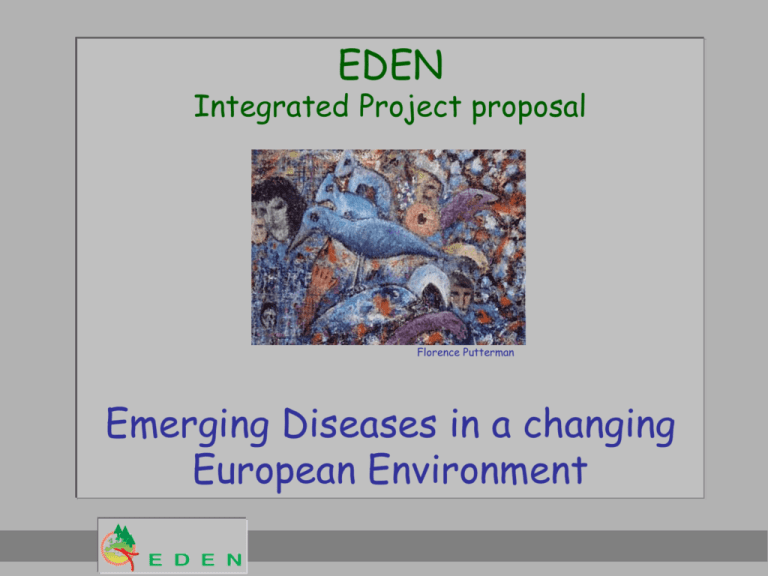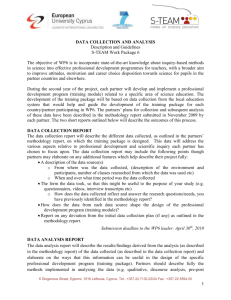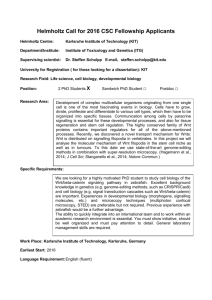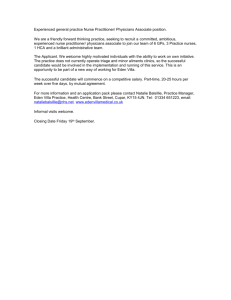EDEN a multiscale integration challenge
advertisement

EDEN Integrated Project proposal Florence Putterman Emerging Diseases in a changing European Environment FP6 call “The aim is to identify, evaluate and catalogue European ecosystems and environmental conditions linked to global change, which can influence the spatial and temporal distribution and dynamics of pathogenic agents. A co-ordinated European approach is needed to provide predictive emergence and spread models including global and regional prevention, early warning, surveillance, and monitoring tools and scenarios. Co-ordination with international organizations and third world countries is essential.” Keywords The aim is to identify, evaluate and catalogue European ecosystems and environmental conditions linked to global change and which can influence the spatial distribution the temporal distribution and the dynamics of pathogenic agents. Coordinated European approach Predictive emergeance and spread models including the following tools and scenarios: - Global and Regional prevention - Early warning - Surveillance - Monitoring Coordination with international organisations and third world countries. PUB/HEALTH & SOCIO ECONOMY AGRO/ECOLOGY Ecosystème Regional/local developpment landscapes economical / social conditions FOCI Climat Vectors Pathogens PATHOGENIC CYCLE Human activities hosts ‘‘indicator diseases’’ •Tick-borne Disease –diseases already present in Europe that have shown significant recent increases in incidence, at least partly due to changes in human behaviour in relation to the environment. •Rodent-borne viruses (hanta, arena, cowpox) – widespread but under-reported diseases within Europe, with strong links with habitat and landscape structures. •Leishmanioses – persistent on the southern fringes of Europe and beyond (southern Mediterranean basin), with the potential to expand as environments change. •West Nile Virus – periodic and occasionally severe local outbreaks, especially on the eastern fringes of Europe, currently showing strong associations with landscape patterns. •Malaria – an ancient scourge of Europe, currently now on her southern and eastern fringes, with the potential for re-emergence following environmental changes. •Maladies Africaines – new strains of West Nile Virus and new diseases such as Rift Valley Fever may be introduced to Europe from tropical regions linked by bird and other (e.g. traded livestock) migratory routes to Europe. A common approach for all Sub-Projects WP / Tasks Patterns Processes Landscape, biotopes and Habitats Description of the environmental components and habitats Monitoring of major environmental events and their consequences on the cycles components Vector Bionomics and Competence Inventory, vectorial capacity and competence of vector populations Monitoring introduction, establishment and spread of vectors Public Health and Human Activities Public health demography of the human populations at risk Monitoring of significant population flows between and in countries Animal reservoirs Epidemiological inventory of the receptive wild and domestic animal populations Monitoring migrations (avifauna), movements and transport (livestock) of the animal reservoirs African Platform Leishmaniasis Malaria Rodent borne diseases Tick borne diseases West Nile Virus Environmental Change Biodiversity Data Management LR Spatial Modelling African Platform Leishmaniasis Malaria Rodent borne diseases Tick borne diseases West Nile Virus Disease Modelling Africa Platform Malaria West Nile Leishmania Rodent borne Tick borne Ecosystem components studies WP1: Landscape, habitat, climate Pattern Process WP2: Vector Pattern Process WP3: Public Health Pattern Process WP4: Animal Reservoir Pattern Process WP5: Individual disease Data management & Modelling Data management & information systems Low resolution spatial modeling WP6 Horizontal activities WP6.2 RS tools Africa Platform Process WP2: Vector Pattern Disease transmission modeling Malaria WP1: Landscape, habitat, climate Pattern WP6.1 Data management West Nile Rodent borne Leishmania Ecosystem components studies Tick borne Horizontal integration Process WP3: Public Health Pattern Process Environmental change monitoring Biodiversity WP6.3 PhD program WP4: Animal Reservoir Pattern Process WP5: Individual disease Data management & Modelling Data management & information systems Low resolution spatial modeling WP6 Horizontal activities WP6.2 RS tools Africa Platform Malaria Process WP2: Vector Pattern Disease transmission modeling Process WP3: Public Health Pattern Process Environmental change monitoring Biodiversity WP6.3 PhD program Emergence & spread models WP1: Landscape, habitat, climate Pattern WP6.1 Data management West Nile Rodent borne Leishmania Ecosystem components studies Tick borne Horizontal integration WP4: Animal Reservoir Pattern Process WP5: Individual disease Data management & Modelling WP7 Overall Integration: Tools & scenarios Data management & information systems Low resolution spatial modeling WP6 Horizontal activities WP6.2 RS tools Africa Platform Malaria Process WP2: Vector Pattern Disease transmission modeling Emergence & spread models WP1: Landscape, habitat, climate Pattern WP6.1 Data management West Nile Rodent borne Leishmania Ecosystem components studies Tick borne Horizontal integration Process WP3: Public Health Pattern Process WP7 Overall Integration: Tools & scenarios Environmental change monitoring Biodiversity WP6.3 PhD program WP4: Animal Reservoir Pattern Process WP5: Individual disease Data management & Modelling WP8: Training, Dissemination, Management & Coordination HEALTH/ENVIRONMENT RESEARCH of model diseases in a variety of representative environmental settings Characterise (new) transmission cycles Identify factors triggering emergence and spread Project strategy TOOLS and POLICIES Catalogue of ecosystems and environmental conditions at risk: “emerging disease hotspots” Develop predictive emergence and spread models Develop early warning, surveillance and monitoring tools Identify environmental changes likely to favour emergence Contribute to decision support and policy making HEALTH/ENVIRONMENT RESEARCH Project strategy of model diseases in a variety of representative environmental settings TOOLS and POLICIES Characterise (new) transmission cycles Identify factors triggering emergence and spread Develop predictive emergence and spread models Identify environmental changes likely to favour emergence EDEN strategy document integrated ‘transdisciplinary’ health/environment approach. Catalogue of ecosystems and environmental conditions at risk: “emerging disease hotspots” Develop early warning, surveillance and monitoring tools Contribute to decision support and policy making EDEN strategy document A key deliverable produced by the Steering Committee and with back-up from the advisory group, specialists with internationally recognised skills in (i) biodiversity monitoring and assessment, (ii) environmental change detection, (iii) disease modelling, remote sensing, image processing and interpretation, and (iv) public health. The EDEN strategy document will propose an innovative integrated ‘trans-disciplinary’ health/environment approach for the unified analysis of the various EDEN outputs. The development of such an approach will be a major breakthrough of EDEN. Objectives timeframe 1 2 3 4 5 SD H&E T&P Dissemination SD: EDEN Strategy document H&E: Health/Environment research T&P: Tools and policies External sources EDEN Indicator Diseases Individual diseases models EDEN Steering Committee Advisory group integrated models health-environment Knowledge Flow DMEWS Disease Monitoring & Early Warning Systems conclusion Annex1, chap 4.1 Contribution to the objectives of the sub-priority “EDEN’s bold ambition is to enable a multi-DMEWS system on a solid scientific foundation running from the theoretical understanding of the reasons for the emergence of new diseases in vulnerable ecosystems, through an understanding of complex disease dynamics, to the practical application of such knowledge to disease control. We do not know the precise shape of this future yet: EDEN presents a chance to Europe to invest in some of the ‘brightest and best’ researchers to ensure success with this vision, and in doing so to advance significantly the state-of-the-art and put Europe firmly at the forefront of DMEWS.”






